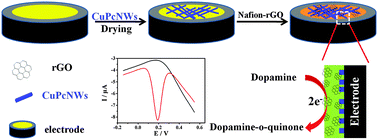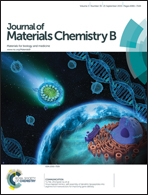Fabrication of metal–organic single crystalline nanowires and reduced graphene oxide enhancement for an ultrasensitive electrochemical biosensor
Abstract
A novel strategy is first presented here to design and construct a good selective and highly sensitive dopamine (DA) biosensor based on single-crystalline CuPc nanowires with a reduced graphene oxide–Nafion film (rGON/CuPcNWs). Metal–organic semiconductor single-crystalline CuPc nanowires with excellent electronic properties and large surface-to-volume ratios were prepared using a physical vapor transport technique and modified onto a glassy carbon electrode (GCE), and exhibited high electrocatalytic activity for DA detection by immobilizing it onto a GCE with a film of the rGON composite. The introduction of a rGO–Nafion film can significantly improve the electrochemical signal of the CuPcNWs. The relevant detection limit toward dopamine is 0.3 nM with a wide linear range from 0.001 μM to 200 μM. The results of the demonstrated biosensor could provide important enlightenment for the design of more sensitive electrochemical biosensors.


 Please wait while we load your content...
Please wait while we load your content...